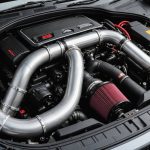Overview of Fog Lights
Fog lights are a crucial component in enhancing vehicle safety during adverse weather conditions. These specialized lights are designed to cut through the fog, illuminating the road with a broad, bar-shaped beam. Unlike regular headlights, which can reflect off fog and impair vision, fog lights are strategically positioned lower on a vehicle to minimize this reflection. This technical placement allows for better visibility close to the road surface, ensuring safer navigation during foggy conditions.
A common question is, “How do fog lights differ from regular headlights?” The primary difference lies in their purpose and design. Headlights, aimed at both short and long distances, illuminate the path ahead under normal driving conditions. Fog lights, however, are specifically engineered for short-range visibility in low-visibility situations like fog, rain, and snow. They prevent the scattering of light, which reduces glare and does not illuminate the particles within the fog itself.
Also read : Ensuring Compatibility: Tips for Integrating Child Safety Seats with Your Vehicle’s Safety Systems
Several misconceptions surround fog lights. Some believe they should be used in all low-light situations. However, fog lights are intended only for extreme weather conditions where standard headlights may impair vision further. Misusing them in clear conditions could reduce their effectiveness and possibly momentarily blind other drivers due to their lower position and beam intensity.
Importance of Visibility in UK Winter Conditions
During the harsh UK winter season, driving safety significantly hinges on visibility. Winter presents challenges such as fog, snow, and relentless rain, complicating even the simplest journeys. These conditions have been shown to severely impair driving visibility, increasing the risk of accidents.
Additional reading : Maximize Your Parking Precision: Tips for Ensuring Your Vehicle’s Parking Assist Thrives in Narrow UK Spaces
Fog is particularly treacherous, often reducing visibility to mere metres. In such conditions, drivers can struggle to discern other vehicles on the road, a dangerous scenario that heightens accident likelihood. Snowfall also obscures vision, muffling contours and leading to further visibility issues. Combined with rain, which causes roads to become slippery, these elements create treacherous driving environments.
The impact on accident rates is substantial. Statistics indicate a direct correlation between reduced visibility during winter and increased vehicle accidents. Data from road safety reports often reveal spikes in collision rates during winter months, where visibility is significantly compromised.
To tackle these UK winter challenges, road users must prioritize maintaining clear views at all times. Encouraging the use of fog lights, regularly cleansing vehicle windows, and slowing down in poor conditions are small but effective measures safeguarding drivers from unnecessary peril. Addressing these visibility concerns not only ensures personal safety but also contributes vastly to wider public road safety during the demanding winter period.
Advantages of Fog Lights
When navigating challenging driving conditions, having the right lighting can make all the difference. Fog lights are specifically designed to enhance visibility in adverse weather, such as fog, rain, and snow, where standard headlights might fall short.
Enhanced Visibility
Fog lights emit a low, wide beam pattern, cutting through fog effectively without reflecting off moisture, which can cause glare. This design is scientifically grounded, focusing on illuminating the road directly in front of the vehicle. Unlike standard headlights, which typically project their beams higher and further, fog lights concentrate on the immediate path and road edges, vastly improving road visibility.
Science Behind the Beam Pattern
The unique beam pattern of fog lights is engineered to extend horizontally and remain low to the ground. By minimizing upward light dispersal, fog lights avoid glare that could be reflected into the driver’s eyes, which is a common issue with regular headlights under poor weather conditions. This ensures a clearer field of view.
Comparative Advantages
Compared to standard headlights, fog lights are especially advantageous during inclement weather. They help drivers distinguish obstacles such as potholes, road signs, and other vehicles, offering a safer navigation experience. Investing in fog lights is a practical decision to improve driving safety in areas prone to unpredictable weather conditions.
Effective Use of Fog Lights
Driving in foggy conditions demands vigilance and proper use of fog lights to ensure safety. Knowing when to activate your fog lights is crucial. Typically, it’s ideal to use them during winter weather, particularly in conditions with reduced visibility, such as thick fog or heavy snow. In these scenarios, fog lights can significantly improve your visibility on the road and help others see your vehicle.
However, various regions have regulations concerning fog light usage. It’s essential to be aware of the laws in your area to avoid fines or safety hazards. For example, in many areas, using fog lights in clear conditions is prohibited, as it can blind oncoming traffic. Always turn off your fog lights when visibility improves to prevent any distractions for other drivers.
For optimal performance, regular maintenance of your fog lights is vital. Here are some tips to ensure they remain in top-notch condition:
- Check for damage: Regularly inspect your fog lights for cracks or other physical damages.
- Clean lenses: Keep the lenses clean for maximum brightness and efficiency.
- Replace bulbs: Swap out dim or burnt-out bulbs promptly to maintain effectiveness.
By adhering to these driving tips and safety measures, you can ensure that your fog lights are used effectively, maximising road safety.
Case Studies and Real-Life Examples
When it comes to fog lights, real-world experiences can illustrate their crucial role in enhancing driver safety. Many driver experiences highlight how critical these lights are during challenging weather conditions.
Consider a scenario where a driver was navigating a foggy road and narrowly avoided a collision, thanks to the visibility provided by fog lights. Such anecdotal accounts, rather than being rare, are quite common, showcasing the pivotal role these lights play in accident prevention. These recounted incidents underline not only the importance of maintaining good visibility but also how fog light effectiveness can provide additional safety measures—not commonly available with standard headlights alone.
Furthermore, documented case studies present compelling evidence of fog light effectiveness in real-life situations. For instance, one study reviewed accident reports from a series of road mishaps. It concluded that vehicles equipped with functional fog lights were involved in fewer collisions in low-visibility conditions compared to those without. This data-driven approach offers concrete assurance of their benefits.
Adding personal safety stories, numerous testimonials from drivers add voices of experience. Many highlighted moments where fog lights contributed to a safe driving outcome, reinforcing why this often-overlooked feature should be a priority for all motorists. These stories substantiate the transformative impact fog lights can have on road safety.
Visual Aids and Demonstrations
In the world of fog lights, understanding their proper use can sometimes be tricky. This is where visual aids step in to illuminate the process. They’re not just supplementary but central to cutting through the fog, quite literally! Diagrams offer a static yet detailed representation, helping you visualise the placement and angle, which is critical for optimal fog light performance. This foundational understanding sets the stage for exploring other forms of instructional content.
Moving on from static images, videos prove particularly effective by showcasing fog lights in action. They can vividly demonstrate their effectiveness in various conditions, from thick misty roads to light drizzle. These dynamic visuals allow you to grasp complex concepts quickly, making them invaluable resources.
For those eager to delve deeper, numerous platforms offer a treasure trove of visual content. YouTube, with its myriad of instructional videos, is a go-to resource for many. Websites dedicated to automotive education often host tutorials, breaking down the nuances of fog light installation and use. By exploring these resources, you’ll find it easy to demystify fog lights, ensuring you’re always poised for the journey ahead.











